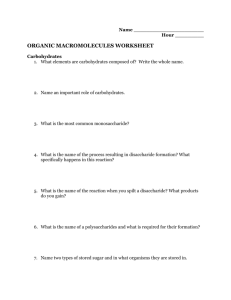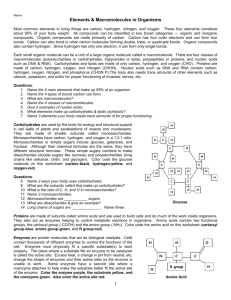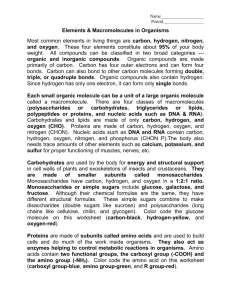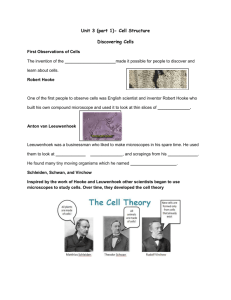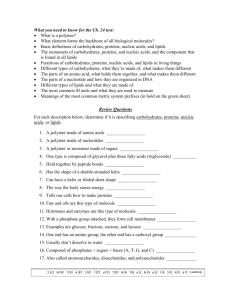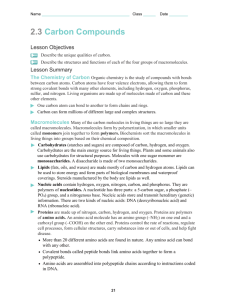Elements & Macromolecules Worksheet: Biology High School
advertisement
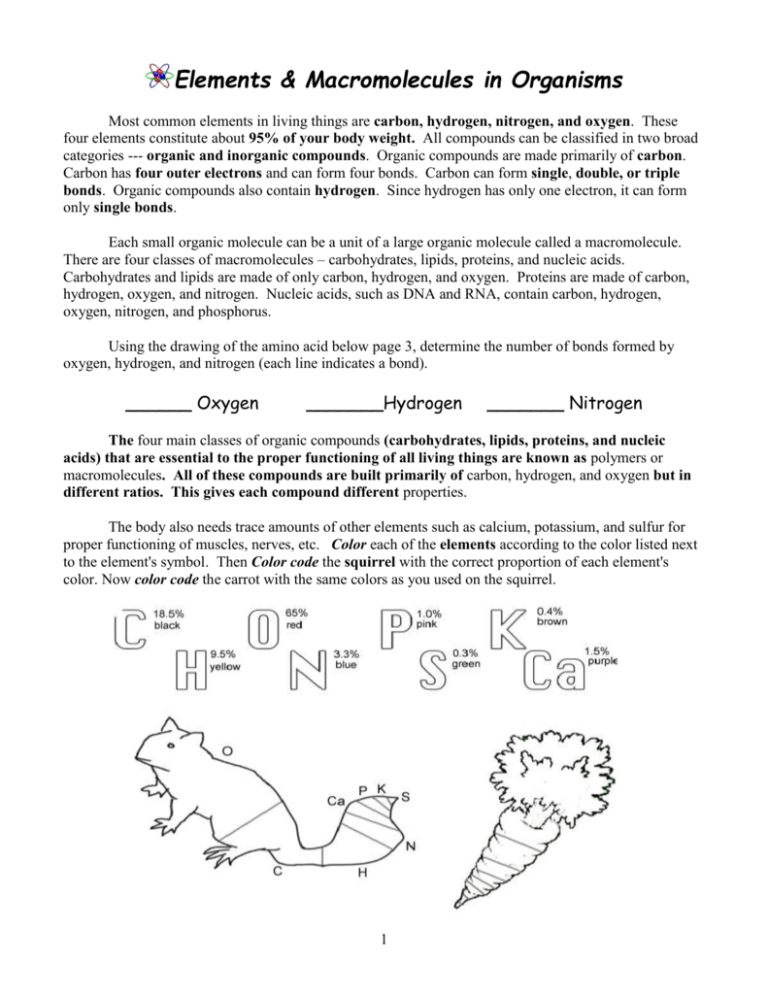
Elements & Macromolecules in Organisms Most common elements in living things are carbon, hydrogen, nitrogen, and oxygen. These four elements constitute about 95% of your body weight. All compounds can be classified in two broad categories --- organic and inorganic compounds. Organic compounds are made primarily of carbon. Carbon has four outer electrons and can form four bonds. Carbon can form single, double, or triple bonds. Organic compounds also contain hydrogen. Since hydrogen has only one electron, it can form only single bonds. Each small organic molecule can be a unit of a large organic molecule called a macromolecule. There are four classes of macromolecules – carbohydrates, lipids, proteins, and nucleic acids. Carbohydrates and lipids are made of only carbon, hydrogen, and oxygen. Proteins are made of carbon, hydrogen, oxygen, and nitrogen. Nucleic acids, such as DNA and RNA, contain carbon, hydrogen, oxygen, nitrogen, and phosphorus. Using the drawing of the amino acid below page 3, determine the number of bonds formed by oxygen, hydrogen, and nitrogen (each line indicates a bond). ______ Oxygen _______Hydrogen _______ Nitrogen The four main classes of organic compounds (carbohydrates, lipids, proteins, and nucleic acids) that are essential to the proper functioning of all living things are known as polymers or macromolecules. All of these compounds are built primarily of carbon, hydrogen, and oxygen but in different ratios. This gives each compound different properties. The body also needs trace amounts of other elements such as calcium, potassium, and sulfur for proper functioning of muscles, nerves, etc. Color each of the elements according to the color listed next to the element's symbol. Then Color code the squirrel with the correct proportion of each element's color. Now color code the carrot with the same colors as you used on the squirrel. 1 Questions: 1. Name the 4 main elements that make up 95% of an organism. 2. Name the 4 classes of macromolecules. 3. Give 2 examples of nucleic acids. 4. What elements make up carbohydrates & lipids (symbols)? 5. Name 3 elements your body needs trace amounts of for proper functioning. Carbohydrates are used by the body for energy and structural support in cell walls of plants and exoskeletons of insects and crustaceans. They are made of smaller subunits called monosaccharides. Monosaccharides have carbon, hydrogen, and oxygen in a 1:2:1 ratio. Monosaccharides or simple sugars include glucose, galactose, and fructose. These are sources of energy for your body. Although their chemical formulas are the same, they have different structural formulas. These simple sugars combine to make disaccharides (double sugars like sucrose) and polysaccharides (long chains like cellulose, chitin, and glycogen). These molecules are used to store energy for short periods of time (hours to days) Color code the glucose molecule below (carbon-black, hydrogen-yellow, and oxygen-red). Use the diagram of glucose to tell how many carbons, hydrogens, and oxygens are in a single molecule. #C _________ # H __________ Glucose Molecule 2 # O __________ Questions: 6. Name 2 ways your body uses carbohydrates. 7. What are the subunits called that make up carbohydrates? 8. What is the ratio of C, H, and O in monosaccharides? 9. Name 3 monosaccharides . 10. Monosaccharides are _______________ sugars. 11. What are disaccharides & give an example? 12. Long chains of sugars are __________________. Name three. Proteins are made of subunits called amino acids and are used to build cells and do much of the work inside organisms. They also act as enzymes helping to control metabolic reactions in organisms. Amino acids contain two functional groups, the carboxyl group (-COOH) and the amino group (NH2). The R group differs for every amino acid, organisms use 20 different amino acid, your body makes 11 of the amino acid you need. Label the amino and carboxyl groups on the amino acid below. Color code the amino acid below (carbon-black, hydrogen-yellow, nitrogen-blue, and oxygen-red). Basic Structure of Amino acid H H N H C R group 3 O C H Amino acids are linked together to form chains called polypeptides. Polypeptide chains join to form proteins. The bonds holding amino acids to each other are known as peptide bonds. Questions: 13. What subunits make up proteins? 14. Proteins also act as ________________ in cells to control reactions. 15. Name the 2 functional groups in amino acids. 16. Chains of amino acids make ____________________________ which can join together to make a ________________________. Lipids are large, nonpolar (won't dissolve in water) molecules. Phospholipids make up cell membranes. Lipids also serve as waxy coverings (cuticle) on plants, pigments (chlorophyll), and steroids. Lipids have more carbon and hydrogen atoms than oxygen atoms. Fats are made of a glycerol (alcohol) and three fatty acid chains. This subunit is called a triglyceride. Color the glycerol molecule using the same colors for carbon, hydrogen, and oxygen as you did before. The fatty acid chains may be saturated (only single bonds between carbons) or unsaturated (contain at least one double bond). Color the fatty acid chains the same colors for carbon, hydrogen, and oxygen as you did before. A special type of lipid called phospholipids help make up the cell membrane. Two layers of these phospholipids make up the membrane. Phospholipids have a "water-loving" hydrophilic head and two "water-fearing" hydrophobic tails. H Glycerol H C O H H C O H H C O H H 4 Saturated fatty Acid H H H H H H H H H H C C C C C C C C C H H H H H H H H H O C O H Unsaturated Fatty Acid - Double Bond H H H H H H H H H H C C C C C C C C C H H H H H H H H H O C O H Questions: 17. Lipids are nonpolar. What does this mean? 18. ___________________________________ make up cell membranes. 19. Lipids have more ___________ and __________ than they do oxygen atoms. 20. Fats are made of an alcohol called _________________ and three ______________ chains. This is known as a _________________________. 21. If there are all SINGLE bonds between ____________ in the fatty acid chain, then it is said to be _________________________. 22. If there is a DOUBLE bond in the fatty acid chain, then it is said to be ____________________. 5 Nucleic acids carry the genetic information in a cell. DNA or deoxyribose nucleic acid contains all the instructions for making every protein needed by a living thing. RNA copies and transfers this genetic information so that proteins can be made. The subunits that make up nucleic acids are called nucleotides. COLOR AND LABEL the parts of a nucleotide --- sugar (5-sided)-green, phosphate group (round)yellow, and nitrogen base (6-sided)-blue. ATP used for cellular energy is a high energy nucleotide with three phosphate groups. Color code the ATP and LABEL THE PHOSPHATES. Nucleotide ATP Questions: 23. Nucleic acids carry __________________ information in a molecule called ______________ or ______________________________ acid. 24. DNA has the instructions for making a cell's _____________________. 25. ______________________________ are the subunits making up nucleic acid. 26. The 3 parts of a nucleotide are a 5 carbon __________________, a _________________, and a ___________________________. 6
